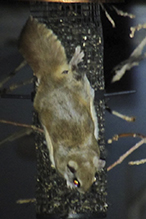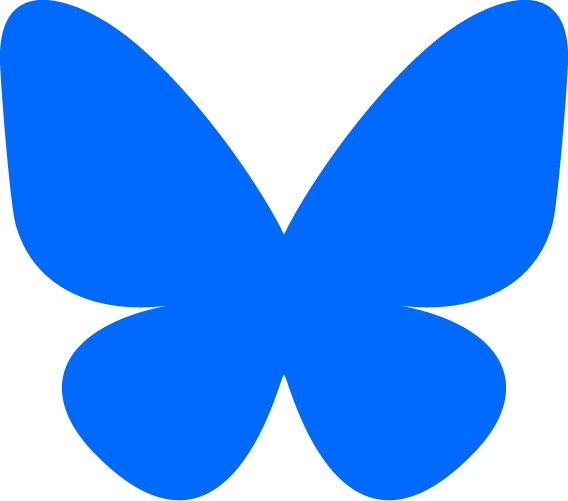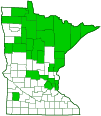Northern Flying Squirrel
(Glaucomys sabrinus)
Conservation • Description • Habitat • Ecology • Distribution • Taxonomy

Conservation Status
IUCN Red List
LC - Least Concern
NatureServe
N5 - Secure
SNR - Unranked
Minnesota
not listed
Description
Northern Flying Squirrel is one of just two flying squirrels in North America. It occurs throughout Canada. In the United States it occurs in the east from Maine west to Minnesota and south to North Carolina, and in the west from Washington east to Montana and south to California. It is absent from the Great Plains and the desert southwest. In Minnesota it is restricted to northeastern half of the state south to the northern Metro area. It is found in coniferous and mixed forests, especially near swamps or streams. It is seldom seen because it remains in its nest until deep dusk and is active only at night.
The adult is 10¾″ to 13½″ in length. The head and body is 5½″ to 5⅝″ (140 to 144 mm) long, the tail 3½″ to 4½″ (89 to 114 mm) long. The eyes are large and black. The skull has 22 teeth. The fur on the upper part of the body is dense, glossy, and olive-brown. The fur on the belly is white at the tips, lead gray at the base. A fur-covered, folded layer of loose skin (patagium) extends along each side of the body from the wrist of the foreleg to the ankle of the hind leg. Among mammals, only flying squirrels and bats have this feature. The tail is broad, flat, and rounded at the end. It is the same color as the back at the base and gets darker approaching the tip. The fur on the tail extends outward at the sides creating a horizontal plane.
Size
Total length: 10¾″ to 13½″
Head and body: 5½″ to 5⅝″ (140 to 144 mm)
Tail: 3½″ to 4½″ (89 to 114 mm)
Sign
Similar Species
Southern Flying Squirrel (Glaucomys volans) is a little smaller and weighs much less. The fur on the back is grayer. The fur on the belly is white all the way to the base. The tail is paler below. The tip of the tail is darker.
Habitat
Coniferous and mixed forests, especially near swamps or streams
Ecology
Behavior
Northern Flying Squirrel is active at night. It remains it its nest until deep dusk.
Lifespan
4 years
Life Cycle
It nests in a hole in a large tree.
Food
Mostly fungi and lichens, but also insects, nuts, seeds, fruit, and buds
Distribution |
||
|
Sources Biodiversity occurrence data published by: Minnesota Biodiversity Atlas (accessed through the Minnesota Biodiversity Atlas Portal, bellatlas.umn.edu, 12/17/2025). Timm, R. M. 1975. Distribution, natural history, and parasites of mammals of Cook County, Minnesota. Occasional Papers, Bell Museum of Natural History, University of Minnesota 14:1–56. Hazard, Evan B. 1982. The Mammals of Minnesota. University of Minnesota Press, Minneapolis, Minnesota. 280 pp. The counties in light green lack modern records but have historic county or township specimens or records. GBIF includes a single record for Lyon County (yellow on the map), but this appears to be a data entry error. The original locality is listed as “Lyons, Nadena Co.”, which is almost certainly a misspelling of Lyons Township in Wadena County. While Lyon County sits well outside the species’ known range, Wadena County is firmly within it. |
|
| 12/17/2025 | ||
Occurrence |
||
Common though rarely seen |
||
Taxonomy
Class
Subclass
Theria
Infraclass
Placentalia (Placental Mammals)
Magnorder
Boreoeutheria
Superorder
Euarchontoglires (Primates, Rodents, and Allies)
Order
Rodentia (Rodents)
Suborder
Sciuromorpha (Squirrels, Dormice, and Mountain Beavers)
Family
Sciuridae (Squirrels)
Subfamily
Sciurinae (Typical and Flying Squirrels)
Tribe
Pteromyini (Flying Squirrels)
Genus
Glaucomys (New World Flying Squirrels)
Subordinate Taxa
Alaska Coast Flying Squirrel (Glaucomys sabrinus zaphaeus)
Atnarko Flying Squirrel (Glaucomys sabrinus reductus)
Bachman Flying Squirrel (Glaucomys sabrinus murinauralis)
Bangs Flying Squirrel (Glaucomys sabrinus bangsi)
Broad-footed Flying Squirrel (Glaucomys sabrinus latipes)
California Coast Flying Squirrel (Glaucomys sabrinus stephensi)
Carolina Northern Flying Squirrel (Glaucomys sabrinus canescens) ![]()
Cascade Flying Squirrel (Glaucomys sabrinus fuliginosus)
Klamath Flying Squirrel (Glaucomys sabrinus klamathensis)
Laborador Flying Squirrel (Glaucomys sabrinus makkovikensis)
Mearns Flying Squirrel (Glaucomys sabrinus lucifugus)
Northern Flying Squirrel (Glaucomys sabrinus macrotis) ![]()
Northern Flying Squirrel (Glaucomys sabrinus sabrinus) ![]()
Okanagan Flying Squirrel (Glaucomys sabrinus columbiensis)
Prince of Wales Flying Squirrel (Glaucomys sabrinus goodwini)
Richardson Flying Squirrel (Glaucomys sabrinus alpinus)
San Bernardino Flying Squirrel (Glaucomys sabrinus californicus)
Sierra Flying Squirrel (Glaucomys sabrinus lascivus)
Virginia Flying Squirrel (Glaucomys sabrinus fuscus)
Yellow-bellied Flying Squirrel (Glaucomys sabrinus flaviventris)
Yukon Flying Squirrel (Glaucomys sabrinus yukonensis)
Synonyms
Pteromys canadensis
Sciurus hudsonius
Sciurus sabrinus
Common Names
Northern Flying Squirrel
Glossary
Patagium
In some mammals, the membrane between the forelimb and the abdomen that assists in flying or gliding. In Lepidoptera, one of a pair of hair-covered, sausage-shaped, scale-like plates on the thorax that cover the wing bases. Plural: patagia.
Visitor Photos
Share your photo of this mammal.
This button not working for you?
Simply email us at info@MinnesotaSeasons.com.
Attach one or more photos and, if you like, a caption.
Molly and Robert Power |
 |
Made a home in a birdhouse! |
Ramona Abrego |
 |
MinnesotaSeasons.com Photos
|

Slideshows

Visitor Videos
Share your video of this mammal.
This button not working for you?
Simply email us at info@MinnesotaSeasons.com.
Attach a video, a YouTube link, or a cloud storage link.
Other Videos
Northern Flying Squirrel (Sciuridae: Glaucomys sabrinus) Close-up
Carl Barrentine
Northern Flying Squirrel (Sciuridae: Glaucomys sabrinus) Close-up of Tail
Carl Barrentine

Visitor Sightings
Report a sighting of this mammal.
This button not working for you?
Simply email us at info@MinnesotaSeasons.com.
Be sure to include a location.
Warren Tinker
1/21/2022
Location: Lavell Township approximately 10 miles South of Hibbing, MN 55746 airport.
I moved here in 1966 and this is the first time that I’ve seen this squirrel.
I stayed up late (10 pm) watching a movie on tv and I kept hearing a small odd noise outside my sliding glass doors.
I have a bird block feeder hanging from the eave of the house for birds and that was where he was.
It was windy with a light snow and he was hanging on to the block cage and having a bite to eat.
I’ve had trouble with racoons and bears over the years and this is one area that they cannot reach.
The squirrel was here for at least 30 minutes. A flashlight did not bother him at all. I only looked long enough to see what it was.
wat
Minnesota Seasons Sightings






